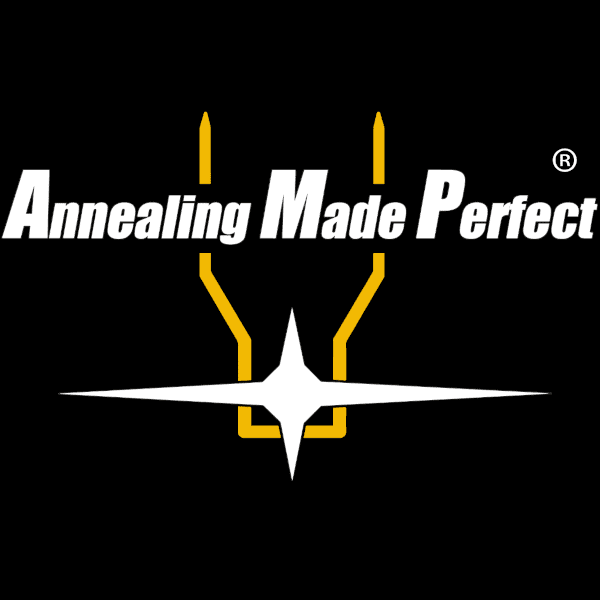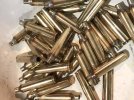I just finished annealing a batch of 100 .350 Rem Mag cases and wondered "How do others do this and with what method?" Growing up, dad considered annealing kind of voodoo-ish. All I remember him doing was either dipping case necks in molten lead or setting cases up in a metal cake pan, putting water in up to the level of the case shoulder, then heating the case necks until they just started to change color and tipping them over into the water. I never really messed with it much until I was necking LC Match 7.62 brass down to .260 Remington specs. Then I decided I should learn to anneal after turning the necks. I found some good advice from John Barsness that has served me well when annealing. He recommends chucking a socket extension into a drill, putting a deep well socket slightly larger than case diameter on to turn the cases at a moderate pace and do it in a dark room, like very dark, and use a propane torch. Start the case rotating, bring the flame in on the bottom side of the case neck that is sticking out from the socket and heat it until you just start to see the brass barely change color and then pull the torch back. The socket serves as a heat sink and protects the rest of the case from the heat. I know there are machines out there that do this automatically, but I can't justify the expense of such a machine for the relatively small amount of annealing I do. How often do you anneal your brass and how frequently?
You are using an out of date browser. It may not display this or other websites correctly.
You should upgrade or use an alternative browser.
You should upgrade or use an alternative browser.
Annealing? How do YOU do it? How often?
- Thread starter selmerfan
- Start date
 Help Support Long Range Hunting Forum
Help Support Long Range Hunting Forum
I use amp annealer every firing
Problem is over annealing and under annealing doesnt help you. There is a window of being correct amp annealer makes it fast and easy
Problem is over annealing and under annealing doesnt help you. There is a window of being correct amp annealer makes it fast and easy
Rick Richard
Well-Known Member
Every firing in Salt Bath
rooster721
Well-Known Member
- Joined
- Jan 6, 2012
- Messages
- 212
Bench Source annealer for me, timed initially per-case & caliber with heat paint, recorded and then annealed for every firing. Years & years ago (faced with less than perfect brass in a favourite caliber) I personally started annealing and also neck turning to bring consistency to my bullet seats and neck tensions. Group size decreased & accuracy increased (dramatically) plus brass life itself more than doubled too. Annealing is a no brainer for serious long range handloading, and is even more so when your calibers brass is of a lesser brand where consistency within the cases themselves is poor to begin with.
Brass imperfections can be corrected greatly, and even very poor brass be made to shoot extremely repeatably, but it takes an effort. I believe alot of the guys headaches with the LRM's that fills thread upon thread on this site with frustrations can probably be fixed up with heavy brass prep like I mention, but it's a topic almost on its own. Point is, if anyones read through those threads, the OP's topic here on annealing would be the first step in litigating those guys' frustrations with loading the LRM caliber.
Either way.. bench source, every firing, and strictly for repeatability load to load for me. Inconsistency is a killer in the LR game. Here's a picture of a half-batch of Lazzeroni Firebird 7mm I did this afternoon... freshly cleaned & annealed, they always look like a million bucks! Smile every time.
Brass imperfections can be corrected greatly, and even very poor brass be made to shoot extremely repeatably, but it takes an effort. I believe alot of the guys headaches with the LRM's that fills thread upon thread on this site with frustrations can probably be fixed up with heavy brass prep like I mention, but it's a topic almost on its own. Point is, if anyones read through those threads, the OP's topic here on annealing would be the first step in litigating those guys' frustrations with loading the LRM caliber.
Either way.. bench source, every firing, and strictly for repeatability load to load for me. Inconsistency is a killer in the LR game. Here's a picture of a half-batch of Lazzeroni Firebird 7mm I did this afternoon... freshly cleaned & annealed, they always look like a million bucks! Smile every time.
Attachments
AMP annealer every firing.
kiwikid
Well-Known Member
Being a Kiwi it was logical to buy the Kiwi made AMP. I anneal after every firing.
Zen Archery
Well-Known Member
- Joined
- Dec 27, 2012
- Messages
- 1,502
Every round. Old school fingers and burner if doing a few rounds. Break out socket and drill if doing more than a dozen.
jjmp
Well-Known Member
Bench Source every round but only after cleaning 
Never heard of it? Quick run down of how?Every firing in Salt Bath
Stugots
Well-Known Member
I use an Amp after every firing as well.
I use the Amp annealer every time my brass is fired.I just finished annealing a batch of 100 .350 Rem Mag cases and wondered "How do others do this and with what method?" Growing up, dad considered annealing kind of voodoo-ish. All I remember him doing was either dipping case necks in molten lead or setting cases up in a metal cake pan, putting water in up to the level of the case shoulder, then heating the case necks until they just started to change color and tipping them over into the water. I never really messed with it much until I was necking LC Match 7.62 brass down to .260 Remington specs. Then I decided I should learn to anneal after turning the necks. I found some good advice from John Barsness that has served me well when annealing. He recommends chucking a socket extension into a drill, putting a deep well socket slightly larger than case diameter on to turn the cases at a moderate pace and do it in a dark room, like very dark, and use a propane torch. Start the case rotating, bring the flame in on the bottom side of the case neck that is sticking out from the socket and heat it until you just start to see the brass barely change color and then pull the torch back. The socket serves as a heat sink and protects the rest of the case from the heat. I know there are machines out there that do this automatically, but I can't justify the expense of such a machine for the relatively small amount of annealing I do. How often do you anneal your brass and how frequently?
Last edited:
Rflshootr
Well-Known Member
Never heard of it? Quick run down of how?

Salt Bath Annealing - Does It Work? | Learn More | AMP
View the latest articles from AMP Annealing. Get tips and tricks from our R&D. Here we upload articles to provide your the best possible information on innovations in the annealing process.
yankee outlaw
Well-Known Member
- Joined
- Apr 7, 2017
- Messages
- 321
bench source every time for me
